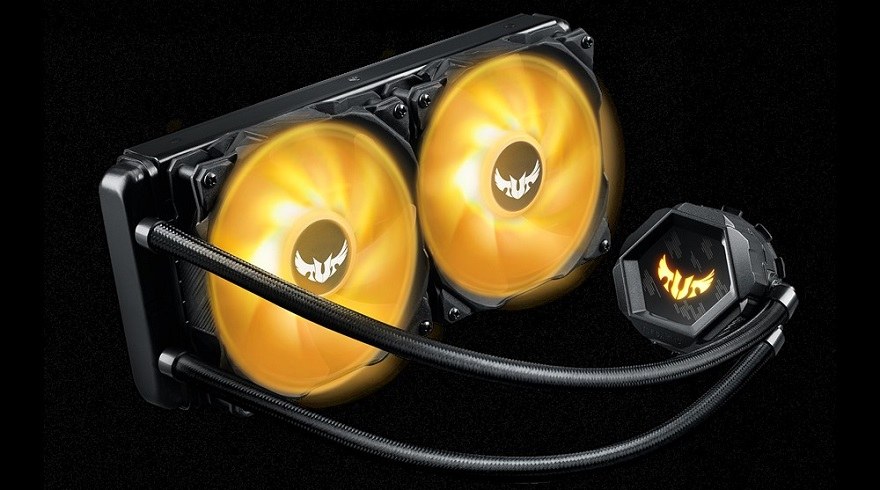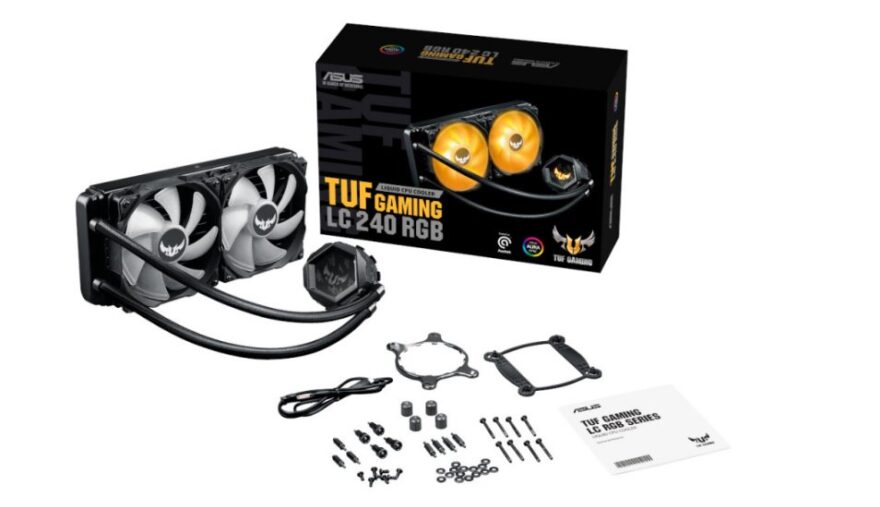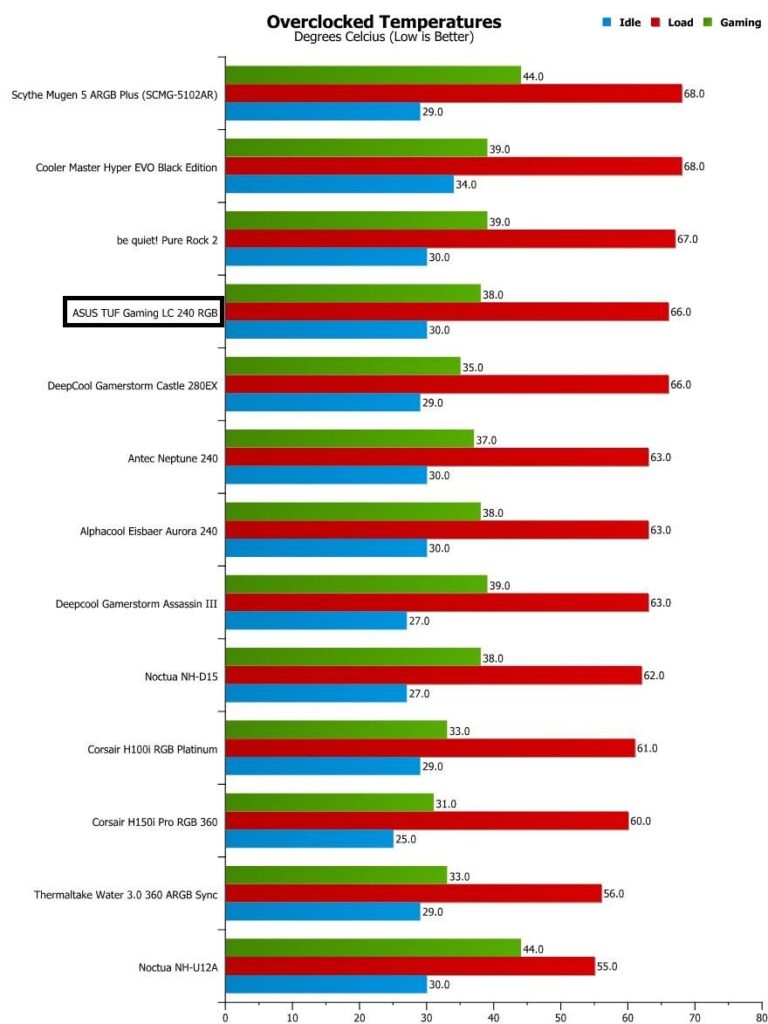ASUS TUF Gaming LC 240 RGB AIO Cooler Review
Mike Sanders / 4 years ago

ASUS has certainly been making efforts since the start of the year to give its TUF Gaming brand a little more prominence. While it’s arguable whether they want it to be perceived as highly as ‘ROG‘ (Republic of Gamers), we’ve seen more than enough recent releases under the TUF Gaming name to suggest that ASUS wants consumers to pay it more attention. Or even to potentially change any misconceptions they may have about it being their more budget-focused range, because in a lot of cases that isn’t really true.
Well, with the release of the ASUS TUF Gaming LC 240 RGB AIO liquid cooler, we certainly seem to have something of more than a little interest here and before we’ve even had a chance to get it out the box, I’m already pretty certain that this is going to be good!

ASUS TUF Gaming LC 240 RGB AIO Liquid Cooler
As a 240mm AIO liquid cooler, the ASUS TUF Gaming LC 240 certainly looks towards ticking all the right boxes. Not only in terms of aesthetics, but also in offering the levels of performance expected from the ASUS brand. With it packed to the gills with impressive features, this certainly appears to be a very potent CPU cooler offering some stylish lighting effects!

Features
- TUF Gaming radiator fans with fan blade groove design for optimized airflow and reduce fan noise.
- NCVM-coating pump cover accentuates the rugged, modern aesthetics
- Styled to complement TUF Gaming motherboards, at the center stage of your build
- Reinforced, sleeved tubing for increased durability

Technical Information
For more in-depth specifications, please visit the official product page via the link here!

Socket Compatibility

What Does ASUS Have To Say?
“TUF Gaming LC RGB is a series of durable CPU liquid coolers designed for mid-sized gaming builds. Each cooler brings the performance, features and design needed to be an essential part of your gaming system. The coolers also include an illuminated RGB TUF Gaming logo with Aura Sync support on the pump housing and radiator fans, giving them a distinctive look.”

Exterior Packaging
While clearly looking to strike a chord with it’s traditional yellow/gold TUF Gaming branding, the front of the packaging gets us off to a good start with a nice clear image of the cooler on display.

The rear certainly goes into more of the technical specifications with a very pleasing to the eye-diagram style highlighting all of the key features from the ASUS TUF Gaming LC 240.

Accessories!
As you might expect, ASUS provides you with everything you need to get this cooler fitted to your PC. While the individual baggage itemization isn’t that fantastic, as long as you pay close attention to the manual (more on this later in the review) you shouldn’t go too far wrong in getting the specific parts you need for your particular socket/motherboard type.

As this is a cooler keen to emphasize RGB lighting effects, you are provided with a multi-connector to ensure you can hook up both fans as well as the pump head. The only minor downside is that this doesn’t come with any RGB light cycle controls and, as such, you’re going to need an ARGB compatible motherboard to get the best out of this.


A Closer Look
Out of the box, the main body of the ASUS TUF Gaming LC 240 AIO liquid cooler has a nice and substantial feel to it. Particularly the pump head which carries a more than distinctive style.

There are, however, of course many separate components to an AIO liquid cooler. Let us, therefore, take a close look at some of the individual aspects of this overall design.

Contact Plate
The contact plate comes with a circular design with thermal-compound pre-applied. In addition, for Intel users, it does also come with the mounting plate pre-installed, however, as part of this review we did remove both this (and the thermal compound) for a more ’rounded’ experience.
In terms of size, the coverage is excellent and, as such, regardless of what processor you have, this should provide some excellent levels of heat transfer.

Pump Head
The pump head itself has a rather distinctive angular design that certainly catches the eye. They are also more than a few indications from this as to where we can expect the RGB light show to be produced.

The top of the pump head carries a little TUF Gaming branding, but without a doubt, the most distinctive aspect is the reflective panel to the top. Although not fantastically visible in the photograph below, one can see the TUF Gaming logo here and, presumably, this will take a whole new life when the RGB is switched on.

Radiator
We have to admit to being more than a little disappointed with the radiator. Yes, with AIO designs they nearly always are black squares, but for the ASUS TUF Gaming LC 240, there is no branding or indeed nothing to distinguish it at all. Yes, with the fans installed most aesthetics would’ve been hidden anyway, but would it really have cost that much to put a little bit of ASUS and/or TUF Gaming branding somewhere on it?…

Fan
The two fans you are provided with come with a nice (if mildly unremarkable) aesthetic. With each coming with 7 fan blades, however, ASUS is keen to emphasize that these do move a decent amount of air and, as such, when installed they should not only look good (particularly when that RGB is turned on), but should also do a more than acceptable job in terms of keeping thermal levels under control.

The fan itself does appear to be an ASUS own ‘TUF FAN’. I must admit, this isn’t a particular design or branding I recognize (having reviewed more than a few TUF Gaming coolers in the past). One can, however, presume that, with it being designed in-house, this is a quality design and has been designed to work perfectly in conjunction with this cooler.

We should also note that the sides of the fan do carry a little bling with an indented pattern clearly on display. This is certainly a little unusual but should, all going well, add significantly to the completed presentation when fitted to the radiator.

Overall
While various aspects of the ASUS TUF Gaming LC 240 might have looked a little bland individually, as a fully-assembled AIO liquid cooler, we must admit to being more than a little impressed. It looks sleek, professional, and dare I say, more than a little stylish.

Looks are, however, only one aspect of an AIO cooler. There are, after all, other important factors to consider such as how easy is it to install and, perhaps most importantly, how well it performs in regards to keeping the CPU nice and cool. Let us, therefore, move away from the design and aesthetics aesthetics and onto some of the more practical aspects!

Installation
I’m going to have to start this aspect of the review on something of a significant downbeat. AIO liquid coolers can be a rather complicated affair and, as such, having a good manual is always reassuring to both beginners and experienced hands. Why do I mention this? Well, the manual for the ASUS TUF Gaming LC 240 is bloody awful. Not only does the quality of the manual itself feel cheap, but the information provided within is unclear, limited, and frankly I think this would genuinely provide people new to AIO coolers with more than a few headaches.

Mounting
Fortunately, if you are mostly familiar with AIO designs, the installation method for the ASUS TUF Gaming LC 240 is, on the whole, fairly straight forward. While the mounting bracket to the pump head is a little unique, it is a design we’ve seen ASUS use many times in the past. While it is certainly different to what you might usually expect, the good news is that it’s actually pretty straight forward and particularly ideal for Intel users as it comes pre-installed out of the box.

Better still, and on a far more basic level, the length of the hose (between the pump head and the radiator) for the ASUS TUF Gaming LC 240 is fantastic. Measuring at least 2-3″ longer than you’d usually see from an AIO, this should ensure that, whatever your chassis is, you shouldn’t have any difficulty in fitting this cooler practically anywhere the case allows.

Overall Thoughts
From out of the box and onto our system, the ASUS TUF Gaming LC 240 took us roughly 15 minutes to install. Certainly not a bad amount of time for an AIO liquid cooler (and particularly a 240mm design). While the (generally terrible) manual certainly doesn’t help matters, once fitted you do have a pretty smart looking cooler on your hands here.

With bright and vivid lighting effects to both the radiator fans and the pump head, this shouldn’t look out of place on any system build. The only mild downside is that you’re going to want to be certain that your motherboard is ARGB compatible as while you are provided with a hub controller, this doesn’t allow for cycling of the RGB effects.

Test System & Methodology
As you may appreciate, we review a lot of coolers here at eTeknix. As such, our prior results sheet was getting more than a little crowded. We have, therefore, applied a new system in which we have picked those coolers we consider most popular or most relevant to this design. Please note that we re-tested the Noctua NH-D15S as our base benchmark for cooling results.
Test system:
- Gigabyte Aorus Gaming 9 Z270
- Intel Core i7-7700K Delidded w/ NT-H1 under IHS
- Radeon R7 Passive GPU with 2GB VRAM
- 16GB Crucial DDR4 2400 MHz (only swapped to 8GB in the unlikely event of RAM compatibility issues)
- 512GB OCZ SSD
- be quiet! Dark Power Pro 800W
- Lian Li T80 Test Bench
- All testing conducted using NT-H1 thermal paste
We’d like to say a big thank you to Gigabyte, Noctua, Crucial, Intel, OCZ, be quiet!, and Lian Li for providing us with the above testing equipment and their on-going support.
Testing Methodology
- We always use Noctua Noctua NT-H1 thermal paste to make sure testing reveals the efficiency of the tested coolers not the efficiency of the bundled thermal paste
- Prime 95 is run for 10 minutes to calculate “load” results
- Unigine Superposition is run for 10 minutes to calculate “gaming” results
- The average temperature across all cores is taken
- Fans are left to operate at default PWM profile speeds unless otherwise stated
- For water cooling tests, all pumps have been operated at 12 volts unless otherwise stated
- Ambient temperatures should be between 21-23 degrees in all our tests unless otherwise stated
- Acoustic measurements are taken 10cm horizontally and 10cm vertically away from the CPU cooler with the VGA fan disabled
- Stock tests are performed using “out of the box” settings for the CPU
- Overclocking tests are performed with the CPU set to 5 GHz and 1.345v
- All coolers were tested under identical settings unless otherwise stated.
- There is approximately a 1-degree Celsius margin of error in our temperature recording software CPUID HW Monitor
- There is approximately a 1.5dBA margin of error with our Benetech GM1351 decibel meter
- In all these graphs we may have a few “reference” results of particular products that do not fit within that category for comparative purposes.
Software Used
- CPUID HWMonitor
- Prime 95
- Unigine Superposition (1080 Extreme)
Performance
Admittedly, in terms of performance, a quick glance at our charts shows the ASUS TUF Gaming LC 240 RGB AIO sitting around the middle in terms of both acoustic performance and temperature control. Is that a bad thing though? Well, no, and largely for two very significant reasons.
Firstly, the results it gave in both tests (stock or overclocked) were well within good remits and secondly, you do have to consider that this AIO cooler is being pitted against some pretty hefty level of competition here. Even with the latter aspect in mind, however, the difference isn’t substantial and, as such, while it might not look impressive, trust us when we say that the ASUS TUF Gaming LC 240 RGB AIO is a bloody good AIO!
Stock Temperatures

Stock Acoustics

Overclocked Temperatures

Overclocked Acoustics

How Much Does it Cost?
At the time of writing, the ASUS TUF Gaming can be purchased for a price in the region of £124.99. While not exactly representing an outright bargain, it’s hard to deny that unlike much of its competition, this certainly offers a number of factors in its favor. Chief among which is the exceptionally elaborate RGB lighting effects on offer.
Yes, RGB isn’t everything, but in a very crowded market, it’s certainly an aspect that (in comparative terms) makes this on a different level to much of its similarly priced competition.
Overview
While the ASUS TUF Gaming LC 240 RGB doesn’t necessarily offer anything new or interesting to the world of AIO liquid cooling, what it does do, it does very well. With both acoustics and temperature control being (possibly) above many consumers’ expectations, the icing on the cake, without a doubt, is the RGB effects. A particular highlight of which is the lighting to the pump head which, again, doesn’t offer anything new, but for an AIO in this price range, it’s certainly enough to tip the scales in its favor.
From easy installation, solid levels of performance, and top-notch RGB lighting effects, as we suspected right at the beginning of this review, the ASUS TUF Gaming LC 240 RGB ticks pretty much all of the right boxes!
Should I Buy One?
Based on the price, in truth, we did partially hope that this would’ve been a little less expensive just to make it an outright no-brainer. The biggest issue the ASUS TUF Gaming LC 240 RGB will have, however, is that the cost puts it bang in the middle of a lot of competition. While it is certainly better than most who share a similar price tag, is what it offers enough to tempt over consumers? Let alone grab people’s attention? We’re not too sure.
It is, however, hard to deny that the ASUS TUF Gaming LC 240 RGB offers a lot of performance for its price tag and, if it does manage to ping up on your radar, it’s definitely worth a look. It’ll easily satisfy your performance needs and, on top of that, likely offers far better aesthetics than a lot of its (similarly priced) competition.
Pros
- Solid levels of both acoustic and temperature control
- A truly viable cooling option for overclocking
- Strong aesthetics with the lights on or off
- Easy to install
- Offers many features comparatively priced coolers do not
Cons
- The instruction manual you are provided with is terrible. Both in terms of its quality and the manner in which information is communicated.
Neutral
- There’s nothing particularly special that makes it stand out from the pack besides the pump head RGB effects. Potentially, a sub £100 steal when sales arrive though!
- No manual RGB controller – An ARGB compatible motherboard is necessary to utilize/cycle the lighting effects.




















